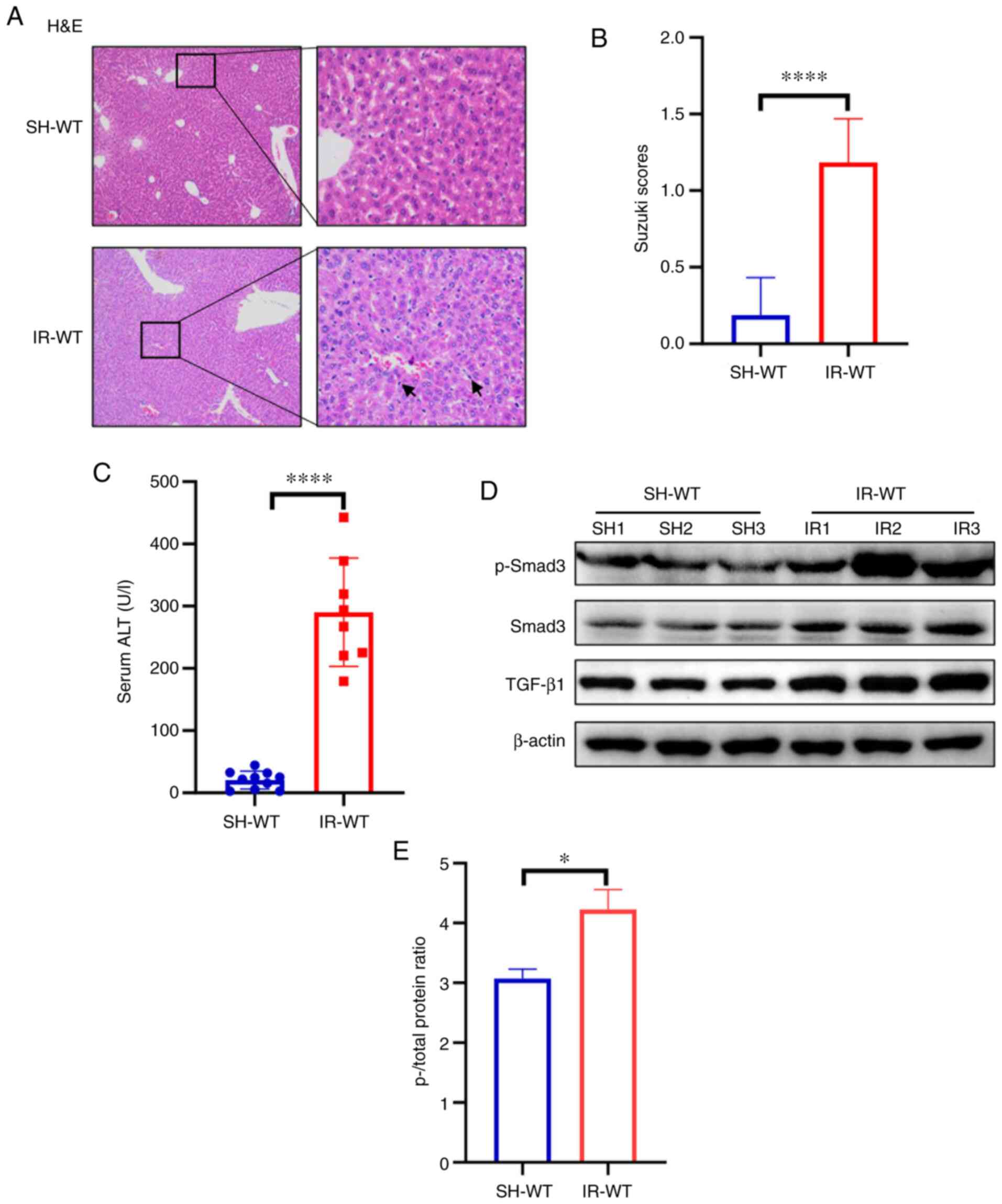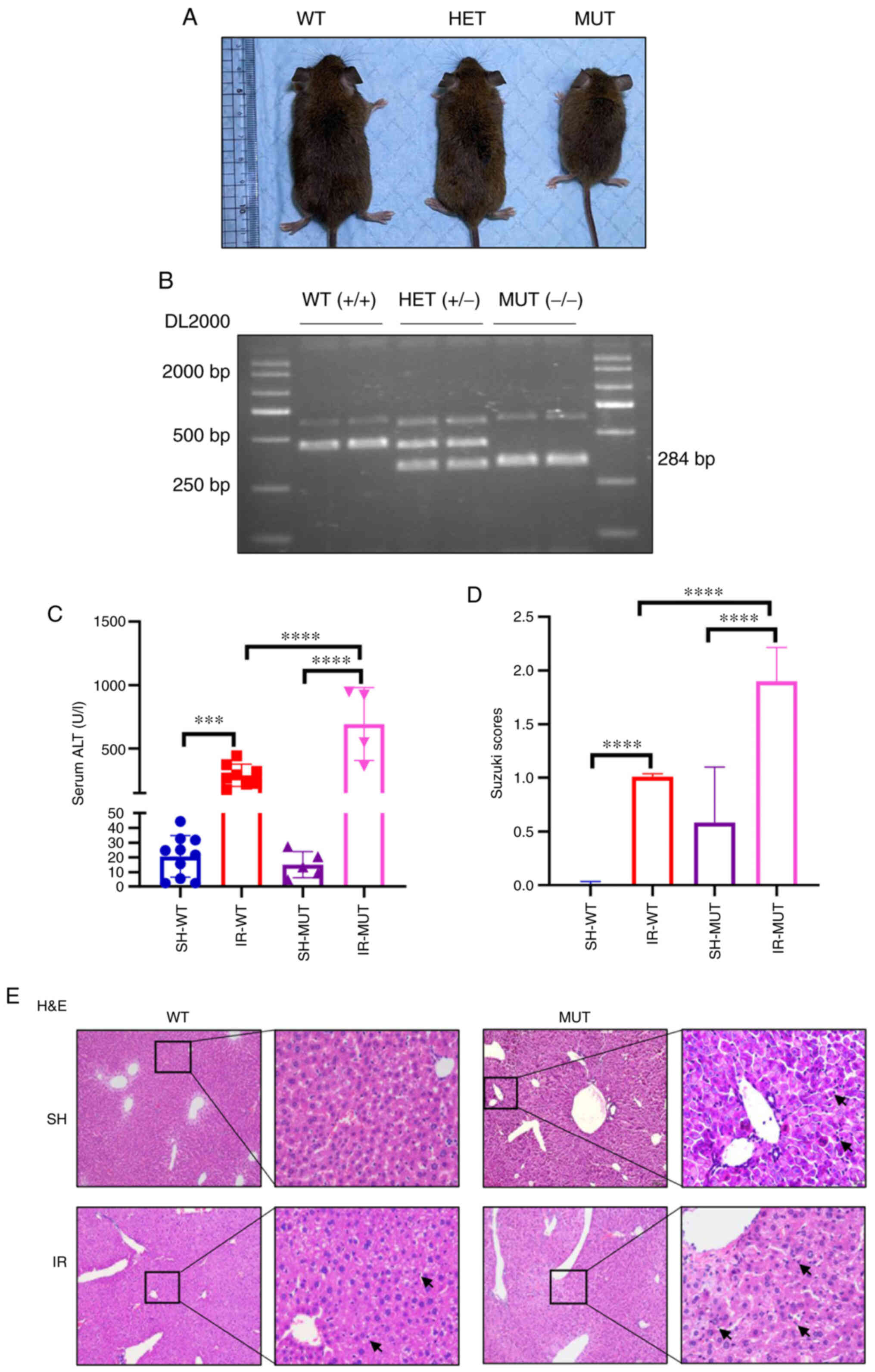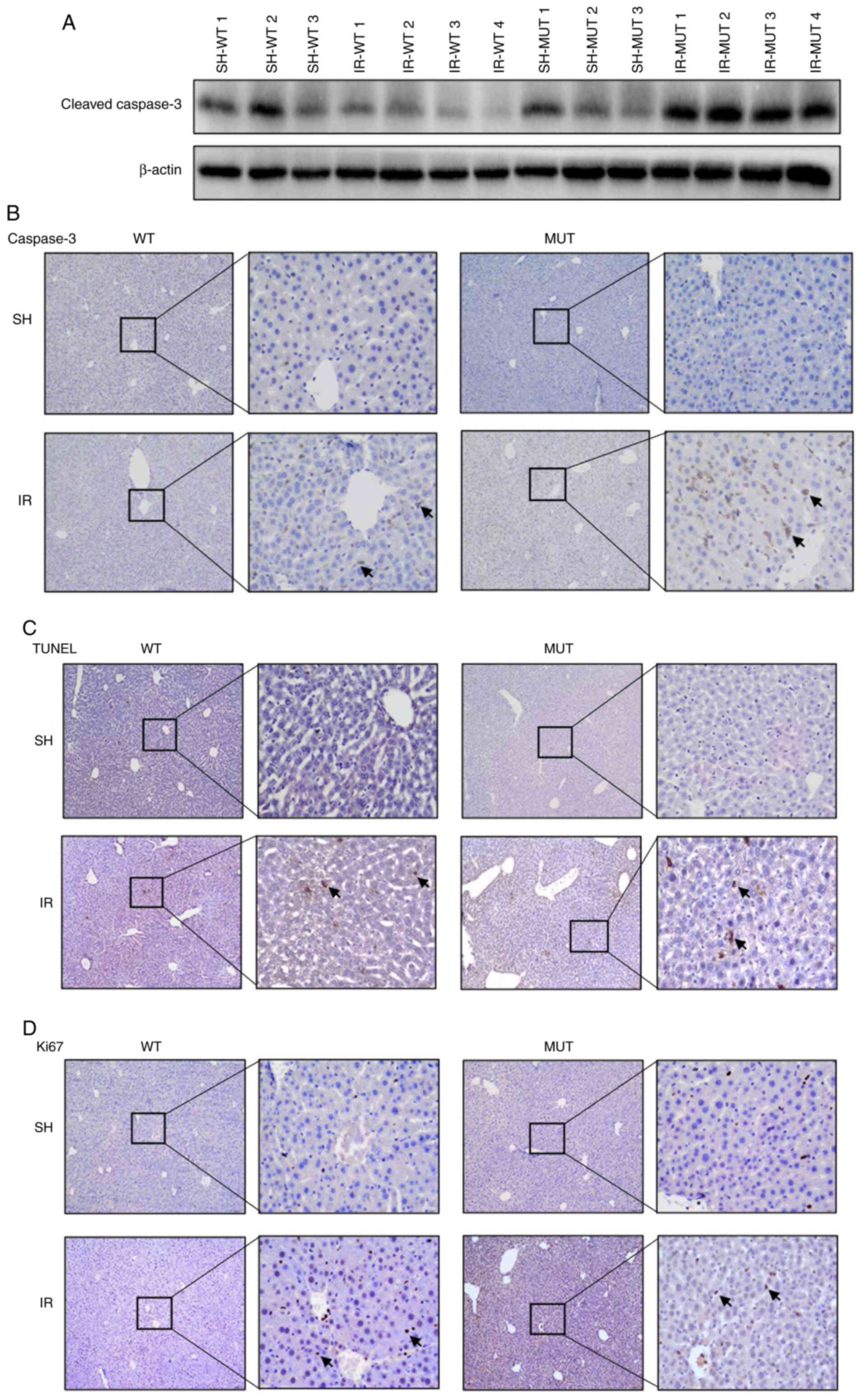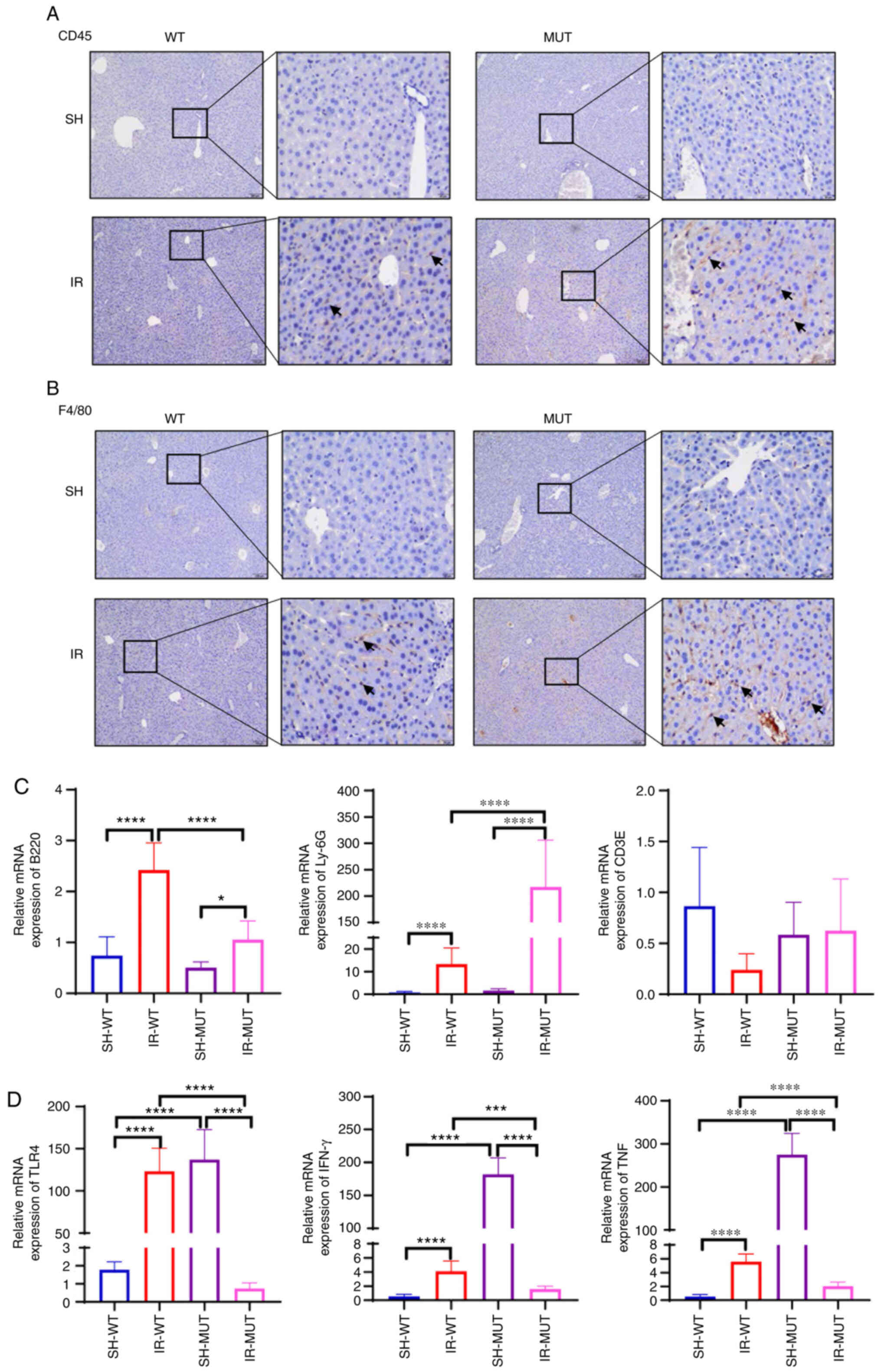|
1
|
Takasu C, Vaziri ND, Li S, Robles L, Vo K,
Takasu M, Pham C, Farzaneh SH, Shimada M, Stamos MJ, et al:
Treatment with dimethyl fumarate ameliorates liver
ischemia/reperfusion injury. World J Gastroenterol. 23:4508–4516.
2017. View Article : Google Scholar : PubMed/NCBI
|
|
2
|
Peralta C, Jiménez-Castro MB and
Gracia-Sancho J: Hepatic ischemia and reperfusion injury: Effects
on the liver sinusoidal milieu. J Hepatol. 59:1094–1106. 2013.
View Article : Google Scholar : PubMed/NCBI
|
|
3
|
Shen XD, Ke B, Zhai Y, Amersi F, Gao F,
Anselmo DM, Busuttil RW and Kupiec-Weglinski JW: CD154-CD40 T-cell
costimulation pathway is required in the mechanism of hepatic
ischemia/reperfusion injury, and its blockade facilitates and
depends on heme oxygenase-1 mediated cytoprotection.
Transplantation. 74:315–319. 2002. View Article : Google Scholar : PubMed/NCBI
|
|
4
|
Zabala V, Boylan JM, Thevenot P, Frank A,
Senthoor D, Iyengar V, Kim H, Cohen A, Gruppuso PA and Sanders JA:
Transcriptional changes during hepatic ischemia-reperfusion in the
rat. PLoS One. 14:e02270382019. View Article : Google Scholar : PubMed/NCBI
|
|
5
|
Suzuki E, Ochiai-Shino H, Aoki H, Onodera
S, Saito A, Saito A and Azuma T: Akt activation is required for
TGF-β1-induced osteoblast differentiation of MC3T3-E1
pre-osteoblasts. PLoS One. 9:e1125662014. View Article : Google Scholar : PubMed/NCBI
|
|
6
|
Derynck R and Budi EH: Specificity,
versatility, and control of TGF-β family signaling. Sci Signal.
12:eaav51832019. View Article : Google Scholar : PubMed/NCBI
|
|
7
|
Brown KA, Pietenpol JA and Moses HL: A
tale of two proteins: Differential roles and regulation of Smad2
and Smad3 in TGF-beta signaling. J Cell Biochem. 101:9–33. 2007.
View Article : Google Scholar : PubMed/NCBI
|
|
8
|
Zou GL, Zuo S, Lu S, Hu RH, Lu YY, Yang J,
Deng KS, Wu YT, Mu M, Zhu JJ, et al: Bone morphogenetic protein-7
represses hepatic stellate cell activation and liver fibrosis via
regulation of TGF-β/Smad signaling pathway. World J Gastroenterol.
25:4222–4234. 2019. View Article : Google Scholar : PubMed/NCBI
|
|
9
|
Inagaki Y and Okazaki I: Emerging insights
into Transforming growth factor beta Smad signal in hepatic
fibrogenesis. Gut. 56:284–292. 2007. View Article : Google Scholar : PubMed/NCBI
|
|
10
|
Li T, Zhao S, Song B, Wei Z, Lu G, Zhou J
and Huo T: Effects of transforming growth factor β-1 infected human
bone marrow mesenchymal stem cells on high- and low-metastatic
potential hepatocellular carcinoma. Eur J Med Res. 20:562015.
View Article : Google Scholar : PubMed/NCBI
|
|
11
|
Porowski D, Wirkowska A, Hryniewiecka E,
Wyzgał J, Pacholczyk M and Pączek L: Liver Failure Impairs the
Intrahepatic Elimination of Interleukin-6, Tumor Necrosis
Factor-Alpha, Hepatocyte Growth Factor, and Transforming Growth
Factor-Beta. BioMed Res Int. 2015:9340652015. View Article : Google Scholar : PubMed/NCBI
|
|
12
|
Wang RQ, Mi HM, Li H, Zhao SX, Jia YH and
Nan YM: Modulation of IKKβ/NF-κB and TGF-β1/Smad via Fuzheng Huayu
recipe involves in prevention of nutritional steatohepatitis and
fibrosis in mice. Iran J Basic Med Sci. 18:404–411. 2015.PubMed/NCBI
|
|
13
|
Park SO, Kumar M and Gupta S: TGF-β and
iron differently alter HBV replication in human hepatocytes through
TGF-β/BMP signaling and cellular microRNA expression. PLoS One.
7:e392762012. View Article : Google Scholar : PubMed/NCBI
|
|
14
|
Akhmetshina A, Palumbo K, Dees C, Bergmann
C, Venalis P, Zerr P, Horn A, Kireva T, Beyer C, Zwerina J, et al:
Activation of canonical Wnt signalling is required for
TGF-β-mediated fibrosis. Nat Commun. 3:7352012. View Article : Google Scholar : PubMed/NCBI
|
|
15
|
Feng XH and Derynck R: Specificity and
versatility in tgf-beta signaling through Smads. Annu Rev Cell Dev
Biol. 21:659–693. 2005. View Article : Google Scholar : PubMed/NCBI
|
|
16
|
Ooshima A, Park J and Kim SJ:
Phosphorylation status at Smad3 linker region modulates
transforming growth factor-β-induced epithelial-mesenchymal
transition and cancer progression. Cancer Sci. 110:481–488. 2019.
View Article : Google Scholar : PubMed/NCBI
|
|
17
|
Liu ZY, Pan HW, Cao Y, Zheng J, Zhang Y,
Tang Y, He J, Hu YJ, Wang CL, Zou QC, et al: Downregulated
microRNA-330 suppresses left ventricular remodeling via the
TGF-β1/Smad3 signaling pathway by targeting SRY in mice with
myocardial ischemia-reperfusion injury. J Cell Physiol.
234:11440–11450. 2019. View Article : Google Scholar : PubMed/NCBI
|
|
18
|
Liu FF, Liu CY, Li XP, Zheng SZ, Li QQ,
Liu Q and Song L: Neuroprotective effects of SMADs in a rat model
of cerebral ischemia/reperfusion. Neural Regen Res. 10:438–444.
2015. View Article : Google Scholar : PubMed/NCBI
|
|
19
|
Percie du Sert N, Ahluwalia A, Alam S,
Avey MT, Baker M, Browne WJ, Clark A, Cuthill IC, Dirnagl U,
Emerson M, et al: Reporting animal research: Explanation and
elaboration for the ARRIVE guidelines 2.0. PLoS Biol.
18:e30004112020. View Article : Google Scholar : PubMed/NCBI
|
|
20
|
Liu Y, Lu T, Zhang C, Xu J, Xue Z,
Busuttil RW, Xu N, Xia Q, Kupiec-Weglinski JW and Ji H: Activation
of YAP attenuates hepatic damage and fibrosis in liver
ischemia-reperfusion injury. J Hepatol. 71:719–730. 2019.
View Article : Google Scholar : PubMed/NCBI
|
|
21
|
Malý O, Zajak J, Hyšpler R, Turek Z,
Astapenko D, Jun D, Váňová N, Kohout A, Radochová V, Kotek J, et
al: Inhalation of molecular hydrogen prevents ischemia-reperfusion
liver damage during major liver resection. Ann Transl Med.
7:7742019. View Article : Google Scholar
|
|
22
|
Livak KJ and Schmittgen TD: Analysis of
relative gene expression data using real-time quantitative PCR and
the 2(-Delta Delta C(T)) Method. Methods. 25:402–408. 2001.
View Article : Google Scholar : PubMed/NCBI
|
|
23
|
Han L, Wang JN, Cao XQ, Sun CX and Du X:
An-te-xiao capsule inhibits tumor growth in non-small cell lung
cancer by targeting angiogenesis. Biomed Pharmacother. 108:941–951.
2018. View Article : Google Scholar : PubMed/NCBI
|
|
24
|
Yang X, Letterio JJ, Lechleider RJ, Chen
L, Hayman R, Gu H, Roberts AB and Deng C: Targeted disruption of
SMAD3 results in impaired mucosal immunity and diminished T cell
responsiveness to TGF-beta. EMBO J. 18:1280–1291. 1999. View Article : Google Scholar : PubMed/NCBI
|
|
25
|
Bravatà V, Cammarata FP, Minafra L,
Pisciotta P, Scazzone C, Manti L, Savoca G, Petringa G, Cirrone
GAP, Cuttone G, et al: Proton-irradiated breast cells: Molecular
points of view. J Radiat Res (Tokyo). 60:451–465. 2019. View Article : Google Scholar
|
|
26
|
Zhai Y, Petrowsky H, Hong JC, Busuttil RW
and Kupiec-Weglinski JW: Ischaemia-reperfusion injury in liver
transplantation--from bench to bedside. Nat Rev Gastroenterol
Hepatol. 10:79–89. 2013. View Article : Google Scholar : PubMed/NCBI
|
|
27
|
Jiménez-Castro MB, Cornide-Petronio ME,
Gracia-Sancho J and Peralta C: Inflammasome-Mediated Inflammation
in Liver Ischemia-Reperfusion Injury. Cells. 8:E11312019.
View Article : Google Scholar
|
|
28
|
Lee PY, Wang JX, Parisini E, Dascher CC
and Nigrovic PA: Ly6 family proteins in neutrophil biology. J
Leukoc Biol. 94:585–594. 2013. View Article : Google Scholar : PubMed/NCBI
|
|
29
|
Xiang S, Chen K, Xu L, Wang T and Guo C:
Bergenin Exerts Hepatoprotective Effects by Inhibiting the Release
of Inflammatory Factors, Apoptosis and Autophagy via the PPAR-γ
Pathway. Drug Des Devel Ther. 14:129–143. 2020. View Article : Google Scholar : PubMed/NCBI
|
|
30
|
Palomino-Schätzlein M, Simó R, Hernández
C, Ciudin A, Mateos-Gregorio P, Hernández-Mijares A, Pineda-Lucena
A and Herance JR: Metabolic fingerprint of insulin resistance in
human polymorphonuclear leucocytes. PLoS One. 13:e01993512018.
View Article : Google Scholar
|
|
31
|
Cutrn JC, Perrelli MG, Cavalieri B,
Peralta C, Rosell Catafau J and Poli G: Microvascular dysfunction
induced by reperfusion injury and protective effect of ischemic
preconditioning. Free Radic Biol Med. 33:1200–1208. 2002.
View Article : Google Scholar : PubMed/NCBI
|
|
32
|
Bielecka-Dabrowa A, Gluba-Brzózka A,
Michalska-Kasiczak M, Misztal M, Rysz J and Banach M: The
multi-biomarker approach for heart failure in patients with
hypertension. Int J Mol Sci. 16:10715–10733. 2015. View Article : Google Scholar : PubMed/NCBI
|
|
33
|
Zhang G, Ge M, Han Z, Wang S, Yin J, Peng
L, Xu F, Zhang Q, Dai Z, Xie L, et al: Wnt/β-catenin signaling
pathway contributes to isoflurane postconditioning against cerebral
ischemia-reperfusion injury and is possibly related to the
transforming growth factorβ1/Smad3 signaling pathway. Biomed
Pharmacother. 110:420–430. 2019. View Article : Google Scholar : PubMed/NCBI
|
|
34
|
Shang J, Sun S, Zhang L, Hao F and Zhang
D: miR-211 alleviates ischaemia/reperfusion-induced kidney injury
by targeting TGFβR2/TGF-β/SMAD3 pathway. Bioengineered. 11:547–557.
2020. View Article : Google Scholar : PubMed/NCBI
|
|
35
|
Wang S, Yin J, Ge M, Dai Z, Li Y, Si J, Ma
K, Li L and Yao S: Transforming growth-beta 1 contributes to
isoflurane postconditioning against cerebral ischemia-reperfusion
injury by regulating the c-Jun N-terminal kinase signaling pathway.
Biomed Pharmacother. 78:280–290. 2016. View Article : Google Scholar : PubMed/NCBI
|
|
36
|
Yang T, Zhang X, Ma C and Chen Y:
TGF-β/Smad3 pathway enhances the cardio-protection of S1R/SIPR1 in
in vitro ischemia-reperfusion myocardial cell model. Exp Ther Med.
16:178–184. 2018.PubMed/NCBI
|
|
37
|
Larsson J, Goumans MJ, Sjöstrand LJ, van
Rooijen MA, Ward D, Levéen P, Xu X, ten Dijke P, Mummery CL and
Karlsson S: Abnormal angiogenesis but intact hematopoietic
potential in TGF-beta type I receptor-deficient mice. EMBO J.
20:1663–1673. 2001. View Article : Google Scholar : PubMed/NCBI
|
|
38
|
Vander Ark A, Cao J and Li X: TGF-β
receptors: In and beyond TGF-β signaling. Cell Signal. 52:112–120.
2018. View Article : Google Scholar : PubMed/NCBI
|
|
39
|
Schepers D, Tortora G, Morisaki H,
MacCarrick G, Lindsay M, Liang D, Mehta SG, Hague J, Verhagen J,
van de Laar I, et al: A mutation update on the LDS-associated genes
TGFB2/3 and SMAD2/3. Hum Mutat. 39:621–634. 2018. View Article : Google Scholar : PubMed/NCBI
|
|
40
|
Waldrip WR, Bikoff EK, Hoodless PA, Wrana
JL and Robertson EJ: Smad2 signaling in extraembryonic tissues
determines anterior-posterior polarity of the early mouse embryo.
Cell. 92:797–808. 1998. View Article : Google Scholar : PubMed/NCBI
|
|
41
|
Stewart AG, Thomas B and Koff J: TGF-β:
Master regulator of inflammation and fibrosis. Respirology.
23:1096–1097. 2018. View Article : Google Scholar : PubMed/NCBI
|
|
42
|
Goumans MJ and Mummery C: Functional
analysis of the TGFbeta receptor/Smad pathway through gene ablation
in mice. Int J Dev Biol. 44:253–265. 2000.PubMed/NCBI
|
|
43
|
Taylor KR, Trowbridge JM, Rudisill JA,
Termeer CC, Simon JC and Gallo RL: Hyaluronan fragments stimulate
endothelial recognition of injury through TLR4. J Biol Chem.
279:17079–17084. 2004. View Article : Google Scholar : PubMed/NCBI
|
|
44
|
Wu H, Chen G, Wyburn KR, Yin J, Bertolino
P, Eris JM, Alexander SI, Sharland AF and Chadban SJ: TLR4
activation mediates kidney ischemia/reperfusion injury. J Clin
Invest. 117:2847–2859. 2007. View Article : Google Scholar : PubMed/NCBI
|
|
45
|
Imai Y, Kuba K, Neely GG,
Yaghubian-Malhami R, Perkmann T, van Loo G, Ermolaeva M, Veldhuizen
R, Leung YH, Wang H, et al: Identification of oxidative stress and
Toll-like receptor 4 signaling as a key pathway of acute lung
injury. Cell. 133:235–249. 2008. View Article : Google Scholar : PubMed/NCBI
|
|
46
|
Liu Q and Zhang Y: PRDX1 enhances cerebral
ischemia-reperfusion injury through activation of TLR4-regulated
inflammation and apoptosis. Biochem Biophys Res Commun.
519:453–461. 2019. View Article : Google Scholar : PubMed/NCBI
|
|
47
|
McCartney-Francis N, Jin W and Wahl SM:
Aberrant Toll receptor expression and endotoxin hypersensitivity in
mice lacking a functional TGF-beta 1 signaling pathway. J Immunol.
172:3814–3821. 2004. View Article : Google Scholar : PubMed/NCBI
|


















